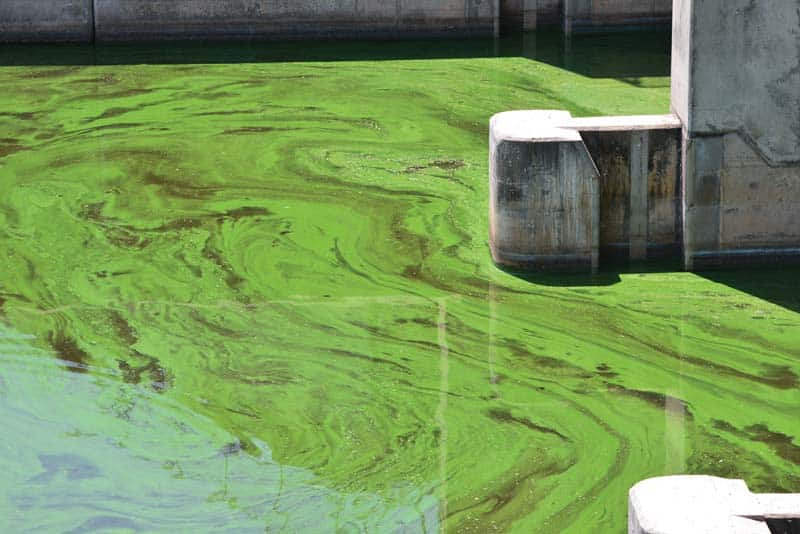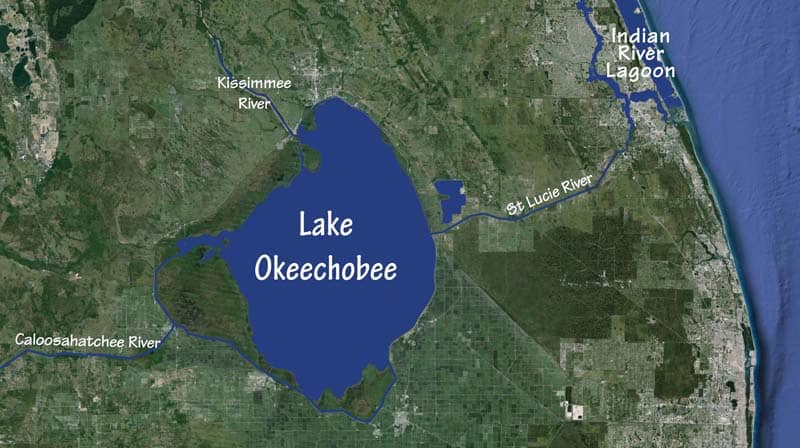Lake Okeechobee is the largest freshwater lake in the state of Florida. Historically, whenever Lake Okeechobee overflowed its natural banks, a sheet of water flowed south, feeding the expansive Everglades. However, after a large storm in 1928 that caused widespread flooding, the federal government authorized the U.S. Army Corps of Engineers to build the Herbert Hoover Dike. In 1930, the Corps built a series of levees, culverts, and locks to encompass the lake, including 67 mi of dikes along the southern shore. Today, the Corps maintains Lake Okeechobee’s water level between 12.5 and 15.5 ft. To maintain these levels, water is discharged, both in low- and high-volume releases, and sent destructively “to tide” through canals and estuaries to the east and west, which has a major ecological impact on the St. Lucie River, Indian River Lagoon, and Caloosahatchee Estuaries.
I grew up playing and fishing by the St. Lucie River. Unlike today, my parents didn’t have to haul me out and say there’s toxic algae in there. When I became a high school student, we met along the St. Lucie and buried outboard motors in protest of the discharges—and that was back in 1970. Today, thousands are protesting.
Not much has changed in the meantime, but there were pioneers (even in those days) like Ernie Lyons and others who fought because they knew that the Lake Okeechobee discharges were killing the watershed. And ever since those early efforts, people have been looking for a Silver Bullet to save the estuaries while also protecting those who live around Okeechobee from a disaster like the one that occurred in 1928.
We all remember the Lone Ranger; he used silver bullets as a symbol of justice and the value of life. He would be careful to use them wisely, but he had six in his gun. After all the meetings I have participated in over the recent decades about our waters, many more people are now taking up our battle cry, “Move Water South,” when it comes to solving the problem of discharges from Lake Okeechobee polluting the St. Lucie River, Indian River Lagoon, and the Caloosahatchee Estuaries.
At last, the U.S. Army Corps of Engineers, South Florida Water Management District, the U.S. Department of Interior, U.S. Congressmen, Florida Legislators, and even the Governor are saying “Move Water South” or its long version: “Stop the Discharges from Lake Okeechobee to the St. Lucie River, Indian River Lagoon, and Caloosahatchee Estuaries and Move the Water South.” This is the Silver Bullet we need, and we should use it now.
Of course, many times I hear people say “there is no silver bullet,” there is no one project, it is complicated, or there are too many constraints in the way. Also presented are several projects that are promoted to “save” the estuaries. However, it is clear to those who work and play in these estuaries that something needs to be done now. It is no longer acceptable to wait and see if, collectively, a series of Band-Aid projects will solve these issues 20 or 30 years from today. All it takes is one long stretch of daily rain for the dumping of millions of gallons of polluted freshwater into the region’s saltwater estuaries to damage oyster beds, spark toxic algae blooms, and poison sensitive species.

In August 2014, an estimated 5,000 persons marched at Phipps Park in Martin County, Florida to protest the Lake O releases. The event was repeated in August 2014.
Photo credit: Cyndi Lenz.
Even as I write this, there are signs of algae again infiltrating the St. Lucie River. Aside from the discharges, human waste from some septic tanks (many which are failing) also contributes to the problem. When that combines with the nitrogen loading caused by agricultural runoff into the Lake Okeechobee, it becomes dangerous to come into contact with the water. During what locals now call the Lost Summer of 2013, St. Lucie oyster beds were so damaged by the freshwater releases into the estuary that they all died—not half of them, not most of them—all of them. Florida Oceanographic Society researchers are rebuilding patches of the decimated oyster beds by collecting shells from nearby seafood restaurants, but the problem is, because this is a recurring event and approximately 100 acres of oyster beds were destroyed, this is only a mitigating strategy until we fix the system.
Furthermore, during the Lost Summer of 2013, the water was deemed toxic by the health department for 5 months and health advisories were issued. Many of those who still ventured into the water developed rashes, fevers, and lung infections.
While it’s not as bad in 2014, there is still more water entering the lake than can go out. We’ve got over 4 billion gallons a day coming in from the Kissimmee and only about 1.6 billion gallons a day going out; but because the lake elevation is lower than the canal elevation, the discharges into the St. Lucie have been limited up to now. What the Army Corp of Engineers has been discharging into the river recently is actually from our own watershed. But you know, all of the water discharged artificially into this estuary is still their responsibility.
We’ve got to stop those discharges whether they’re from Lake Okeechobee or the local watershed, and we’ve got to lean on the elected officials of our state and our nation. I’ve meet with some of our state lawmakers and attended numerous meetings to address the water quality problems linked to Lake Okeechobee discharges, and there has been some progress, at least insofar as we have their attention in what is currently an election year, but progress is still slow.
In my opinion, the lack of effective action stems from a lack of incentive on the part of big agriculture. If the flood gates from Lake Okeechobee flowing to the coastal estuaries were scheduled for permanent closure or a federal judge ruled that no more discharges into the estuaries shall be permitted, then a Silver Bullet project would quickly find funding.
Some have said that if we just build all of the projects in the Comprehensive Everglades Restoration Plan (CERP) over the next 30 years that this will fix everything. However, the one and only “Silver Bullet” project out of the 68 projects in CERP that is supposed to solve the Lake Okeechobee discharges to the estuaries (known as the Lake Okeechobee ASR project) is insufficient. You might say it is more like a “copper bullet” and will melt in the barrel if we try to use it.
It is not that complicated. Here’s a summary of the Silver Bullet: 1) Conveyance: Increase the conveyance capacity of the three gate structures and canals going south from the Lake to equal or exceed that which is currently going east and west.
2) Storage: Buy an additional 50,000 acres of land in the Everglades Agricultural Area (EAA) south of the Lake and build the storage capacity to handle the water from the Lake temporarily as it moves south.
3) Treatment: Slowly release the water into the A1, A2, Stormwater Treatment Areas, and public lands south of the storage for water quality treatment as it moves into the Water Conservation Areas and the Everglades.

Blue-green algae bloom east of structure S-308, Lake Okeechobee area on August 2014. When the St. Lucie lock and dam gates are opened (structure S-80), toxic algae flows from the C-44 canal and into the St Lucie Estuary. Photo credit: Paul Shidel
Widely known as Plan Six, the concept refers to a proposed storage flow-way that would allow a large amount of water from Lake Okeechobee to flow south.
The storage flow-way would occupy and move through approximately one-fifth of the Everglades Agricultural Area, much of which already is in public hands and some that is readily available.
Unfortunately, that goal will not be achieved under the present Comprehensive Everglades Restoration Plan. Only a storage flow-way south from Lake Okeechobee can largely alleviate the destruction of the east-west estuaries, which are among the most diverse in the nation.
There are several projects that are always discussed, underway, or in process, such as restore the Kissimmee River, dispersed water storage, C44 project, IRL South, Picayune Strand, CEPP, and C43. All will help get some of the water right in the local watersheds and attenuate some flows, but none are the solution to our main problem for the estuaries. Of course, we should continue projects that retain water upstream and treat pollution at the source, but we still need a Silver Bullet: a project that will truly stop the discharges from Lake Okeechobee to the St. Lucie River, Indian River Lagoon, and Caloosahatchee Estuaries and move the water south to restore the Everglades River of Grass. And we need it now, before the estuaries take another hit like the Lost Summer of 2013.
There’s a section in the Florida Constitution, under Article 2, Section 7, entitled Natural Resources and Scenic Beauty, that reads “It shall be the policy of the state to conserve and protect its natural resources and scenic beauty. Adequate provision shall be made by law for the abatement of air and water pollution and of excessive and unnecessary noise and for the conservation and protection of natural resources.”
Every elected official, including our Governor, took an oath to defend this constitution. In fact, the Governor appoints the nine members of the South Florida Water Management District, he appoints the head of the Florida Department of Environmental Protection, and he influences the State Legislature. So, whether it’s the Governor or the State Legislature, they have both the power and the responsibility to protect our natural resources and stop this pollution—even to tell the federal government to stop dumping polluted freshwater into our estuaries and to send clean water south. Voters also have a say. Not only is there a big push to elect politicians willing to fight this battle with a Silver Bullet, but in November, the state will vote on Amendment 1, which, if passed, funds the Land Acquisition Trust Fund by dedicating 33% of net revenues from the existing excise tax on documents for 20 years. This fund will be used to acquire, restore, improve, and manage conservation lands—including wetlands and forests; fish and wildlife habitat; lands protecting water resources and drinking water sources, including the Everglades—as well as the water quality of rivers, lakes, and streams; beaches and shores; outdoor recreational lands; working farms and ranches; and historic or geologic sites.

Protesters gather at the locks where water containing high levels of phosphours and nitrogen is regularly released into the St. Lucie Estuary. The water lowers the salinity level of the brackish estuary killing oysters and seagrass. Photo credit: Cyndi Lenz.
If Amendment 1 passes, it will boost efforts to eliminate harmful discharges from Lake Okeechobee to the St. Lucie River, Indian River Lagoon, and Caloosahatchee Estuaries. Combined with the Silver Bullet described above, including the ecologically and economically feasible conveyance of water southward from Lake Okeechobee, this approach is capable of providing multiple restoration functions, including conveyance, storage, and pre-treatment of excess nutrients before they reach the Everglades.
The estuaries discussed in this article can rebound, but they need a break from these discharges and they need it now. Like any rescue effort, there will be major challenges to stopping the discharges and moving the water south, but when you consider the alternatives, which are rampant algae blooms, continued disease and death among sensitive species, and reduced recreational usage of the waterways by residents and tourists, it’s clear that the net benefits of this Silver Bullet far outweigh any of those issues. For more information, visit www.floridaocean.org.

